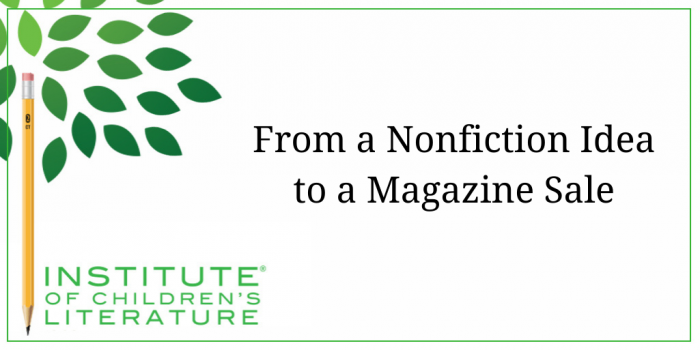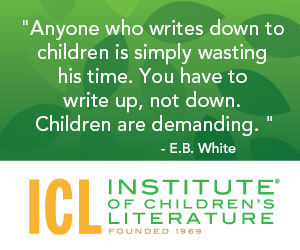1000 N. West Street #1200, Wilmington, DE 19801
© 2024 Direct Learning Systems, Inc. All rights reserved.

We teach our students how to write and get published!
View our Course Catalog >
Writing nonfiction for magazines offers a publication opportunity for many writers. Nonfiction is used by more magazines (and more publishers, in general) and it helps writers build skills in research, organization, and submission.
Also, since trade book publishers are focused on narrative nonfiction at the moment, magazines are an excellent opportunity for writers who enjoy expository nonfiction (the nonfiction built upon learning about a topic via facts rather than the more story-like approach of narrative nonfiction). Still, if you’ve never published anything in a magazine, knowing the process can be helpful, so let’s go through the actual process for selling a piece of expository nonfiction, one that required a fair bit of research. Let’s start with the nonfiction idea that stumbled upon me.
I like butterflies, and one day I began poking around the internet looking for pretty photos of butterflies. I wasn’t thinking about writing an article about butterflies, because I knew most magazines get far more insect-related nonfiction than they can possibly buy. Instead I was considering creating a butterfly craft and was seeking inspiration. Also I was procrastinating and looking at pretty pictures is great for that. Then I ran across an article about unusual insects that mentioned the Harvester butterfly piercing the bodies of woolly aphids to drink their fluids. The idea of a little butterfly vampire immediately grabbed my attention. Kids would love that! Thus, began my research on the Harvester butterfly. I wasn’t sure a publishable piece would come of it, since I knew insects were a bit of a no go for editors, but I wanted to know more.

After doing a fair bit of my own reading, I interviewed a graduate student at Yale who had been researching carnivorous caterpillars around the world and this particular butterfly as North America’s only example – because of his active research I could count on him to give me the straight story and to be my expert reviewer. Many magazines like knowing an expert went over your manuscript before you sent it. The grad student graciously agreed to do so and was a huge help. He even suggested some books where I might do more reading on the Harvester. These were academic books well over the heads of my readers (and sometimes over my head as well) but every bit of information helped me be certain I understood the topic so I could share it with children without introducing any errors based on my own mistakes.
I chased the story of these wonderful little butterflies and grew more and more fascinated with them. Through my research I began to believe the unique aspects of the Harvester butterfly would overcome any resistance to one more insect article coming into a magazine for submission. Finally, I wrote the article. I sent the manuscript, bibliography, and cover to Cricket magazine. A solid bibliography is essential to selling nonfiction, so I made sure to send it along. It would help convince the editor that the article I sent wouldn’t be error ridden. Although I had sold fiction to Ladybug (which is part of the Cricket Media Group), I had never sold the group any nonfiction, and I knew my manuscript would go to a first reader. As a result, I didn’t even bother coming up with the name of an editor [You’ll notice I chose not to use “Dear Editor” as my salutation. I know that’s acceptable but I don’t like it so I don’t do it.] Here’s my cover for the article:
Greetings,
“Carnivorous Butterflies” – the idea sounds like something from a bad 50s horror movie; but the caterpillar of one small North American butterfly really is a hungry predator. The harvester butterfly caterpillar preys upon wooly aphids using a unique disguise. He becomes a wolf in sheep’s clothing by cloaking himself in the drained bodies of his victims. I believe your readership will enjoy reading about this unusual creature.
My writing credits have included such varied magazines as Ladybug, Highlights, and Boy’s Quest. Thank you for your consideration. I look forward to hearing from you.
One thing both queries and covers are for me is short. I know that it’s the article itself which makes the sale, not my letter writing ability.
I received a letter of interest in reply. Cricket was interested in my article but wanted more of a twist to the ending. Something funny or something unusual. They wanted the article to end with a bit of a bang. No problem. I spent some time thinking about it and sent back the twist. They liked it. This was followed by a few exchanges concerning sources. Cricket is very concerned with accurate sources and having only one source for some information (even if he was a researcher who had spent more time with the butterflies than anyone else) made them nervous so I had to drop some bits that I really liked. I found other things that were just as interesting to replace them. The Cricket editor also wanted me to add some things that I had left out intentionally because I knew kids in the Cricket age group have really done metamorphosis to death in school – but no matter how many times you hear it, I suppose the idea of the butterfly ripping his way from the chrysalis and drying his wrinkled wings to fly is always interesting.
My little article wasn’t the most important think on the Cricket editor’s plate and it was far from the most important thing to the magazine in general. Because of that, long periods – days or weeks – sometimes passed between communications as we worked to bring my article up to what they wanted. Many times, the changes were small but Cricket is serious about not making changes without letting you know so the back-and-forth editing process can seem endless. Thankfully, this was just a small thing on my plate too. I cannot imagine how excruciating it would have been if this was my first article and I was counting the days to acceptance.
Finally the changes were all acceptable, and I was told a contract would be forthcoming. Not quickly forthcoming, mind you, but forthcoming. Eventually, it forth came. I signed the contract sealing the deal for publication of the article I had begun over a year previously. Then came the time to wait for publication. Eventually it did come. In fact, for this particular piece, publication came exactly five years from the time I began considering writing it. I’ve waited far longer for publication with Highlights. In my experience, smaller magazines often publish more quickly, so that’s something to consider. I didn’t really mind the wait as I liked the prestige of publishing with Cricket. Unfortunately one thing that comes with Cricket publication is another long, long wait for the payment. Highlights is definitely quicker there, but I like a nice spread of credits and magazines so I was happy to add Cricket to my publications list.
Children did enjoy the Harvester caterpillar piece and I even did school visits based on the story of the vampire caterpillars. The kids at the visits loved hearing about North America’s only carnivorous caterpillar. Since then I’ve done a number of visits on books I’ve written, but no other bit of writing ever produces the questions from kids that carnivorous caterpillars does. So, the process was long, the pay not huge, and it did require patience, but I am proud of the work and the delight it’s met with readers. As a writer, there are few things better.
With over 100 books in publication, Jan Fields writes both chapter books for children and mystery novels for adults. She’s also known for a variety of experiences teaching writing, from one session SCBWI events to lengthier Highlights Foundation workshops to these blog posts for the Institute of Children’s Literature. As a former ICL instructor, Jan enjoys equipping writers for success in whatever way she can.
1000 N. West Street #1200, Wilmington, DE 19801
© 2024 Direct Learning Systems, Inc. All rights reserved.
1000 N. West Street #1200, Wilmington, DE 19801
© 2024 Direct Learning Systems, Inc. All rights reserved.
1000 N. West Street #1200, Wilmington, DE 19801
© 2024 Direct Learning Systems, Inc. All rights reserved.
1 Comment